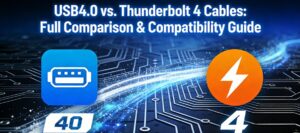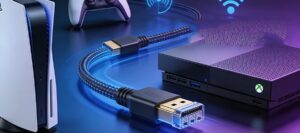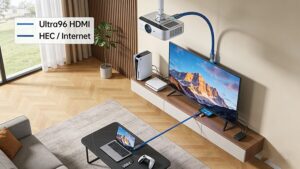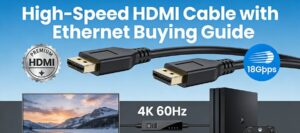USB Type-C Cable, often referred to simply as USB-C, is a modern and highly versatile connector standard that offers numerous advantages over its predecessors, such as USB Type-A and USB Type-B. Here’s a detailed overview of the advantages of USB Type-C cables:
Advantages of USB Type-C Cables
Reversible Connector
- Ease of Use: One of the most significant advantages of USB-C is its reversible connector. Unlike previous USB connectors, which have a specific orientation, USB-C can be plugged in either way. This eliminates the frustration of trying to insert the connector the wrong way.
- User-Friendly: The symmetrical design of the USB-C connector makes it more user-friendly, especially in low-light conditions or when accessing ports that are difficult to see.
Universal Standard
- Compatibility: USB-C is becoming a universal standard for various devices, including smartphones, tablets, laptops, cameras, and even some gaming consoles. This widespread adoption means that a single USB-C cable can be used across multiple devices, reducing the need for multiple types of cables.
- Future-Proof: As more manufacturers adopt USB-C, it is likely to remain relevant for years to come, making it a future-proof investment.
High Data Transfer Speeds
- USB 3.1 and Beyond: USB-C cables support high data transfer speeds, especially when paired with USB 3.1, USB 3.2, or USB4 standards. USB 3.1, for example, offers data transfer rates of up to 10 Gbps, while USB4 can reach speeds of up to 40 Gbps.
- Efficiency: These high data transfer speeds are beneficial for quickly transferring large files, such as high-resolution videos, photos, and backups.
Power Delivery (PD)
- Fast Charging: USB-C cables support the USB Power Delivery (PD) standard, which allows for significantly higher power levels compared to previous USB standards. USB PD can deliver up to 100 watts of power, enabling fast charging for smartphones, tablets, and even laptops.
- Versatility: The ability to deliver high power levels means that USB-C can be used to power a wide range of devices, from small peripherals to large laptops.
Video Output
- Alternate Modes: USB-C supports alternate modes, such as DisplayPort, HDMI, and Thunderbolt 3, allowing it to transmit video signals. This capability makes it possible to connect USB-C enabled devices directly to monitors, TVs, and projectors.
- Single Cable Solution: The ability to handle data, power, and video through a single cable reduces cable clutter and simplifies connectivity setups.
Backward Compatibility
- Adaptability: USB-C is backward compatible with previous USB standards (USB 2.0, USB 3.0, etc.) through the use of adapters. This ensures that older devices can still be used with newer USB-C cables and ports.
- Transition Ease: The backward compatibility facilitates a smoother transition from older USB standards to USB-C, allowing users to gradually upgrade their devices and accessories.
Applications of USB Type-C Cables
Smartphones and Tablets
- Charging and Data Transfer: USB-C is commonly used for charging and data transfer in modern smartphones and tablets, offering fast charging and high-speed data transfer capabilities.
- Audio and Video: Some smartphones use USB-C for audio output, eliminating the need for a separate headphone jack.
Laptops and Computers
- Power Delivery: Many modern laptops use USB-C for charging, taking advantage of the high power delivery capabilities.
- Peripheral Connections: USB-C ports are used for connecting peripherals such as external hard drives, mice, keyboards, and docking stations.
Monitors and Displays
- Single Cable Solution: Some monitors offer USB-C connectivity, providing power, data, and video transmission through a single cable.
Things to Keep in Mind
- Compatibility: While Type-C is becoming universal, some older devices may not support it. Be sure to check the specifications of your devices before purchasing Type-C cables or accessories.
- Power Delivery Standards: Not all Type-C cables support the same power delivery levels. Always double-check the specifications to ensure you get a cable that meets your charging needs.







